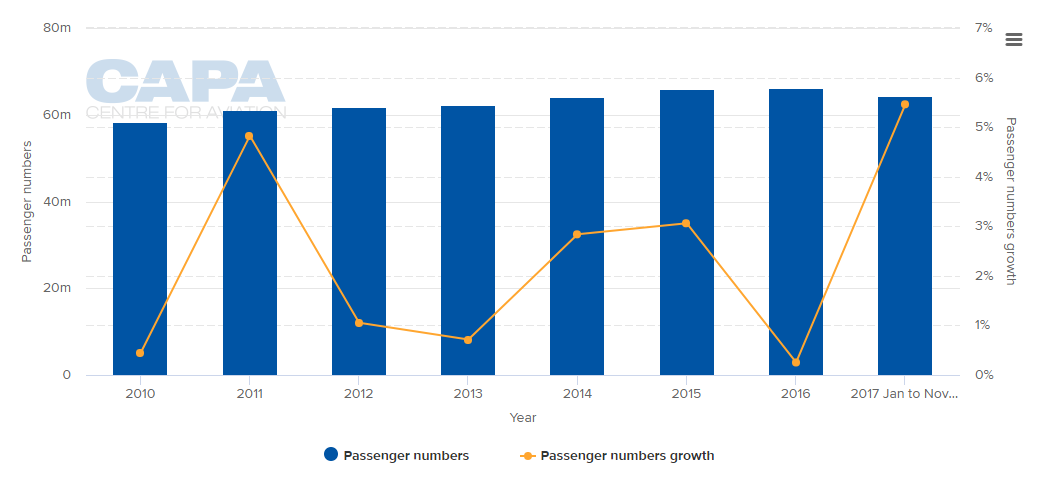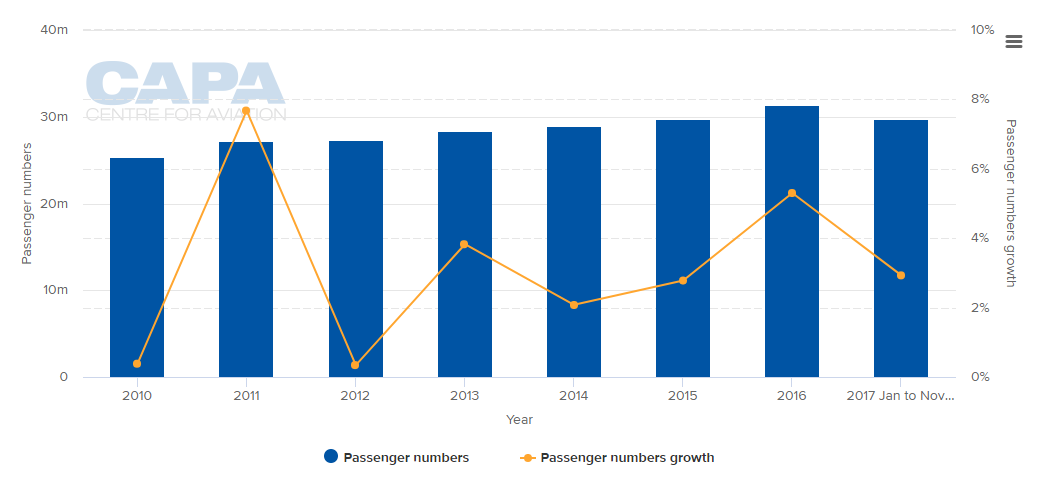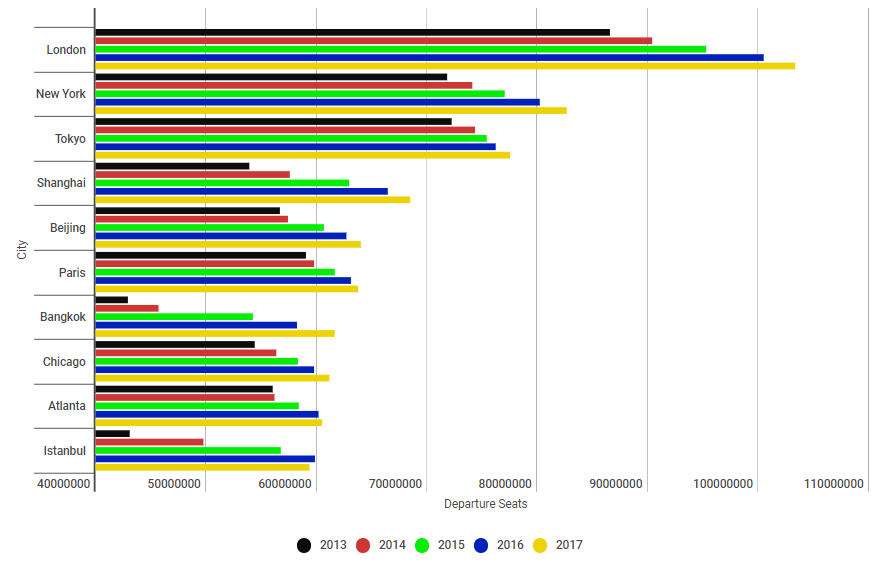Summary:
- Paris Aeroport confirmed late last year that that it had handled over 100 million passengers in a calendar year fore the first time ever.
- The French capital joins a elite list of cities whose airports handle over 100 million passengers each year, in Atlanta's and Los Angeles' case this has been achieved at just one airport.
- Alongside Paris, the 100mppa club includes Atlanta, Chicago, London, Los Angeles, New York, Shanghai and Tokyo.
The bulk of that passenger traffic goes though CDG, the world's 10th busiest airport in 2016 with almost 66 million passengers. Orly is less than half of CDG's size, with 31.2 million passengers in that year. CDG is more 'international' too, with 91.7% of its seat capacity currently (w/c 25-Dec-2017) on international services, compared with 69.6% at Orly.
In doing so Paris enters what is a small but not necessarily exclusive club, in that its other members are not all capital cities. The largest of them all though, London, is. Together, the combined London airports (Heathrow, Gatwick, Stansted, City, Luton and Southend), all under different owners with no duplication, recorded over 163 million passengers in 2016, well ahead of second-placed New York (J F Kennedy, LaGuardia, Newark Liberty and Stewart airports) on 129.6 million.
CHART - The main air transport gateway into Paris, Charles De Gaulle airport handled 5.5% more passengers over the first eleven months of 2017 versus the same period the previous year, its fastest annual rate of growth this decade Source: CAPA - Centre for Aviation and OAG
Source: CAPA - Centre for Aviation and OAG
It is no surprise that those two cities, New York and London, are the only two to record an Alpha ++ rating in the Globalisation and World Cities (GaWC) Index that is managed by the UK's Loughborough University.
Listed in the GaWC Index as an Alpha + city, Tokyo is the third of the three premier global financial cities and one would expect a heavy throughput at its airports. The total in 2016 was 118.5 million at the two main airports of Haneda and Narita.
China's entry into the club is not Beijing, where there is only one main airport until the new Daxing one opens in 2019, with a first-stage capacity of 45 million ppa. In 2016 Beijing Capital Airport alone handled 94.5 million passengers however, and its recent annual growth rate suggests the 100 million barrier could be broken this year. But for now the Chinese torchbearer is Shanghai. It's Pudong and Hongqiao airports jointly witnessed 106.5 million passengers passing through in 2016.
One airport that does have over 100 million passengers on its own account is the mighty hub of Atlanta Hartsfield-Jackson in the US, which recorded 104.3 million of them in 2016. However, unlike most of the other airports mentioned here its growth rate is slowing. It was only 2.7% in 2016 and in the first ten months of 2017 that had shrunk to just 0.1%, a rate that is of concern to its management and which indicates that Beijing Capital would overtake it within three years. (It probably would not do so because of some traffic redistribution to Daxing; there is no prospect of the same at Atlanta as proposals for an alternative airport there have been rebuffed).
CHART - Formerly Paris' international airport, Orly is now a secondary gateway to the city, albeit still served by 30 airlines and linked to around 120 destinations mainly by LCC and leisure focused networks. It grew its passenger traffic by 2.9% across the first eleven months of 2017 Source: CAPA - Centre for Aviation and OAG
Source: CAPA - Centre for Aviation and OAG
Another US city apart from New York and Atlanta that has broken the 100 million barrier is Los Angeles, which racked up 102.7 million passengers in 2016 across five airports (Los Angeles International or LAX; Long Beach; Hollywood Burbank; John Wayne Orange County and Ontario International). However, some of the airports are not actually in Los Angeles County and there are question marks as to whether Ontario should be counted in at all as it mainly serves the so-called 'Inland Empire' to the east of Los Angeles, a region of its own with over four million inhabitants.
The US's other great metropolis, Chicago, just scrapes in with 101 million passengers in 2016, including the small Chicago Rockford Airport (0.2 million) along with O'Hare and Midway.
One city that rarely comes to mind in these calculations is Moscow. In 2016 the combined passenger totals at Sheremetyevo, Domodedovo, Vnukovo and Zhukovsky airports came to approximately 78 million (figures for Zhukovsky are estimated) so Moscow still has some way to go to get close to the 100 million club. Even so it is a powerful aviation city, responsible for about half of all Russian passenger journeys (and similar to London in that respect).
Coming up on the ropes are Dubai (89 million passengers in total recorded at the International and World Central airports as of 24-Dec-2017), although growth there has faltered recently; also Istanbul, where the total was 89.7 million (Atatürk and Sabiha Gökçen airports) in 2016 and where growth has resumed after a difficult political period last year.
Surprisingly perhaps another contender for entry into the club is Bangkok, whose Suvarnabhumi and Don Mueang airports jointly hosted 91 million passengers in 2016 and where growth in 2017 (first ten months) has been around 8% in both cases. If and when the U-Tapao Rayong Pattaya Airport is expanded and treated formally as a Bangkok airport that total will quickly rise well beyond 100 million ppa on current form.
Seoul in South Korea is another city that might not immediately come to mind but its passenger figures in 2016 were impressive, with 82.8 million of them between the Incheon and Gimpo airports.
There are continents where no city seems to be anywhere near achieving the credentials required for entering this 100 million club, namely Central and South (Latin) America, where the largest aviation cities (Sao Paulo and Mexico City) hosted respectively 57.4 million and 42.4 million passengers in 2016. Also Africa, where the largest aviation city is Johannesburg, with 22.6 million between the O R Tambo and Lanseria airports.
However, the situation in Mexico City could change when the New Mexico City Airport opens in its first stage in 2020. Eventually it will have capacity for 120 million passengers annually though how quickly that target will be reached is open to debate.
The Blue Swan Daily analysis of OAG schedule data shows that almost all ten of largest global city markets in terms of departure seats grew by between 0.1% and 3.0% in 2017. The only exceptions were Bangkok - which grew 6.0% and continues to rise the city capacity rankings (up to seventh in 2017 from tenth in 2016) - and Istanbul, where capacity declined 0.8% on 2016.
CHART - London remains the world's leading city market with departure capacity having risen 16.0% over the past ten years Source: The Blue Swan Daily and OAG
Source: The Blue Swan Daily and OAG